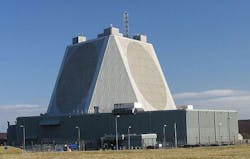Northrop Grumman to upgrade U.S. early warning military radar to help prevent ballistic missile attack
PETERSON AIR FORCE Base, Colo. –Military radar experts at Northrop Grumman Corp. will modernize and upgrade three ageing ground-based warning radar systems to help protect the U.S. and its allies from enemy ballistic missile attack.
Officials of the Air Force Life Cycle Management Center at Peterson Air Force Base, Colo., announced a maximum $866 million five-year contract Friday to the Northrop Grumman Mission Systems segment in Chantilly, Va., to modify and sustain the Precision Acquisition Vehicle Entry Phased Array Warning System (PAVE PAWS); the Ballistic Missile Early Warning System (BMEWS); and the Perimeter Acquisition Radar Attack Characterization System (PARCS).
PAVE PAWS is a ground-based radar system that provides U.S. Strategic Command (USSTRATCOM) at Offutt Air Force Base near Omaha, Neb., with warning and attack-assessment information on all intercontinental ballistic missiles (ICBMs) launched throughout the world that might be headed for U.S. territory.
BMEWS, meanwhile, is a ground-based radar system that helps warn USSTRATCOM and NATO authorities of submarine- and sea-launched ballistic missile (SLBM) attacks and provides data to help evaluate the severity of ballistic missile attacks.
PARCS is a large radar installation in North Dakota that provides ballistic missile warning and attack assessment, as well as space surveillance data to the North American Aerospace Defense Command (NORAD) Peterson Air Force Base, Colo., as well as to USSTRATCOM and regional combatant commanders. PARCS monitors and tracks more than half of all Earth-orbiting objects with its AN/FPQ-16 phased-array radar system pointed northward over Hudson Bay, and analyzes more than 20,000 tracks per day, from giant satellites to space debris.
The PAVE PAWS and BMEWS beam steering unit (BSU), receiver exciter (REX), receiver beam former (RBF), array group driver (AGD), radio frequency monitor (RFM), frequency time standard (FTS), and the corporate feed (CFD) were built for these five radars in the late 1970s and were upgraded in the 1980s, Air Force officials say.
The REX and FTS already have been redesigned and upgraded at Beale Air Force Base, Calif., Fylingdales, England, and Thule, Greenland sites as part of the Upgraded Early Warning Radar (UEWR) programs. They were to be upgraded at the Clear, Alaska, and Cape Cod, Mass., sites by 2016 or 2017, officials say.
Yet the PAVE PAWS and BMEWS radars have not received upgraded array front-ends in more than 20 years, and this equipment is nearing obsolescence, and requires a substantial technology-refresh effort.
The PARCS signal processing group (SPG) consists of 10 cabinets of equipment with hundreds of unique parts. The SPG generates frequency-modulated pulses for transmission, spectrum inversion, and pulse compression; performs side lobe reduction; as well as compares and processes track signals, multiplexing, and signal conversion. Extensive alignment and maintenance are necessary to maintain proper signal reception and analog digital conversion, Air Force officials explain.
On this contract Northrop Grumman will do the work in Colorado Springs, Colo., and at other locations, and should be finished by May 2023.
For more information contact Northrop Grumman Mission Systems online at www.northropgrumman.com, or the Air Force Life Cycle Management Center at www.wpafb.af.mil/aflcmc.
Ready to make a purchase? Search the Military & Aerospace Electronics Buyer's Guide for companies, new products, press releases, and videos

